The History of Kalamazoo County, Michigan
Click photos below
for expanded views
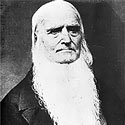
| 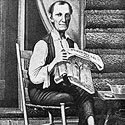
| 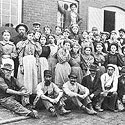
| 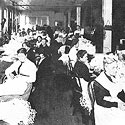
| 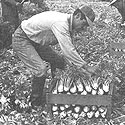
| 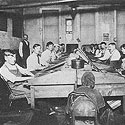 |
Bazel Harrison, Benjamin Harrison and William Henry Harrison each left a mark on history. Benjamin, Bazel's uncle, signed the Declaration of Independence. William Henry, Bazel's cousin, became president of the United States. Bazel, a Maryland native, was Kalamazoo County's first white settler. In the fall of 1828, at the age of fifty-seven, he led an entourage of men, women, children, pigs and sheep to Prairie Ronde, a 14,000-acre Michigan grassland.
Prairie Ronde was the largest of eight prairies whose agricultural potential attracted both pioneers and speculators to Kalamazoo. After traveling through the county in 1833, New Yorker Charles Hoffman wrote, "To no scenery of our country that I have yet seen is the term 'Arcadian' more applicable than to the rich and fairy landscape ... watered by the Kekalamazoo [sic] and the St. Joseph's [rivers]."
One of Kalamazoo's first speculators was Lucius Lyon. A Vermont native who surveyed land in the Old Northwest Territory from 1823 to 1832, Lyon platted the village of Schoolcraft near Prairie Ronde in the fall of 1831. Schoolcraft grew as it served those who settled on the prairie, but it soon fell behind the more centrally located settlement founded by Titus Bronson.
In 1830, Bronson, who was described as a wild eccentric, had purchased a beautiful burr oak plain near the head of navigation of the Kalamazoo River. Bronson's site also intersected the planned Territorial Road, and in 1831, bearing the name of its founder, it was selected as the county seat.
Organized in 1830, Kalamazoo County derived its name from the Potawatomi Indian word for boiling water, Kikamasung. (Boiling water may have referred to the eddies in the rapids of the Kalamazoo River or to a legend about a footrace from the Indian village near Galesburg to the Kalamazoo River that required the runner to reach the river and return before a pot of water began to boil.) The county enjoyed quick settlement, and Bronson became its political, economic and social focus. In 1832 Justus Burdick purchased one-half of the community from Bronson for $850. He then built the Kalamazoo House, a 30' x 40' two-story hotel. The transfer of the land office from White Pigeon, St. Joseph County, to Bronson in 1834 boosted the community's growth. According to one nineteenth-century historian, Bronson became "one great mass convention of men almost raving with land mania." A shortage of accommodations left men pitching tents all over the area, and the Kalamazoo House served meals continuously from morning to night. In 1836 the land office sold 1.6 million acres and collected $2 million in receipts-more than any other land office in the nation.
In 1836 the eccentricity of the town's founder prompted residents to change the community's name to Kalamazoo. Indignant, Bronson moved to Illinois.
A decade after Bronson purchased his land along the Kalamazoo River, Kalamazoo County boasted over seven thousand people, making it Michigan's ninth most populated county. The village of Kalamazoo included 250 houses, 10 dry goods stores, 6 physicians and a newspaper, the Kalamazoo Gazette, which recorded, "youthful bloom and manhood's vigor are everywhere." By 1860, Kalamazoo County's population had reached twenty-five thousand, and its county seat was Michigan's fifth largest town.
Kalamazoo's first major industry was agriculture. During the early 1840s, David Walbridge operated a barge system that transported the county's produce to the mouth of the Kalamazoo River. There it was transferred to larger vessels and sent east. The arrival of the railroad in Kalamazoo in 1846 enhanced the county's agricultural potential, though it made the barge system obsolete. By the mid-1850s, Kalamazoo was one of the state's leading farming counties, ranking third in both corn harvested and pork marketed in 1854. Its harvest of 585,000 bushels of wheat on the eve of the Civil War placed it fifth among all sixty counties.
During the mid-1830s, while most Kalamazoo farmers laboriously harvested grain by hand, attorney James Hascall and pioneer Hiram Moore began operating a mechanical harvester on the Climax Prairie in eastern Kalamazoo County. The machine, built by Moore, could cut, thresh, clean and bag grain at the rate of twenty acres a day. Patented in 1837, the harvester cut a fourteen-foot swath and was drawn by sixteen horses with four drivers. Hascall and Moore built several harvesters (estimates vary). In 1844 the Michigan Farmer and Western Agriculturalist exclaimed, "It would make a Green Mountain boy stare to see one of these noisy voracious monsters, as he clatters along the plain ... as he crosses the bending heads of wheat with his iron teeth, scatters the straw in seeming wantonness around him, and hurls the chaff in clouds."
Locals accurately predicted that no invention ranked "higher in the prospect of future usefulness than the Harvester," but Moore's harvester proved too unwieldy and expensive to compete with other reapers, most notably Cyrus McCormick's. When his patent expired, Moore left Kalamazoo and his mechanical tinkering.
During the antebellum period, Kalamazoo County also established itself as a leader in Michigan education. In 1833 the Michigan Territorial Legislature chartered the Baptist-sponsored Michigan and Huron Institute "to promote the knowledge of all those branches of education usually taught in academies and collegiate institutions." The institute opened in Kalamazoo in 1836. The following year the University of Michigan opened a branch in Kalamazoo. The two academies soon merged, with the university providing financial support to the newly named Kalamazoo Literary Institute. The closing of the university's branches in the late 1840s seemed to spell doom for the institute: however, the school's new principal, Dr. James A. B. Stone, and his wife, Lucinda, not only resolved the institute's financial problems, but actively involved it in contemporary reform movements, such as abolition, temperance and woman's rights. (Mrs. Stone operated the school's female department and was later instrumental in the post-Civil War campaign to enroll women in the University of Michigan.) In 1855 the institute became Kalamazoo College and received the right to confer degrees.
Besides excelling in antebellum agriculture and education, Kalamazoo was the site of Abraham Lincoln's only Michigan speech. Not yet the well-known figure he would become after his 1858 U.S. Senate campaign in Illinois against Stephen Douglas, Lincoln addressed the thousands who gathered in Kalamazoo on 27 August 1856 to demonstrate their support for John C. Fremont, the Republican party's first presidential candidate.
Speaking to an audience described by one historian as "full of hell and hilarity-hell for Democrats and slave-owners, and hilarity for the Young Republicans of Michigan"-Lincoln agreed that in light of the slave controversy in Kansas, the question of slavery "should be not only the greatest question, but the sole question" on their minds. But the Illinoisan refused to incite the crowd's sectional ill-feeling. Others were not so circumspect. Detroiter Zachariah Chandler argued, "Let Kansas come in as a slave state and the North will make it a desert."
Recognizing that a sectional party like the Republican needed Democratic converts to achieve political success, Lincoln concluded by asking his political opponents to realize that their party's refusal to oppose slavery's extension had turned the Democrats "away from their love of liberty." Lincoln urged, "Throw off these things, and come to the rescue of this great principle of equality ... And not to Democrats alone do I make this appeal, but to all who love these great and true principles. Come and keep coming! Strike, and strike again! So sure as God lives, the victory shall be ours!" Fremont lost the 1856 presidential election, though Michigan and Kalamazoo County voted Republican. Four years later, both the state and county again supported the Republican presidential nominee, and Lincoln became president.
During the post-Civil War period, though Kalamazoo lost its battle with Grand Rapids to become western Michigan's main metropolis, it continued to grow and developed a wide range of industries based on the county's entrepreneurial and agricultural resources.
Taking advantage of the area's bountiful water resources, in 1867 the Kalamazoo Paper Company opened its first mill. According to historian Larry Massie, the company provided a training ground for paper makers and "was one reason for the amazing proliferation of paper mills throughout the Kalamazoo Valley." The area's proximity to Chicago, its excellent railroad network and its large labor force further aided the industry's development. By the early twentieth century, Kalamazoo County was the state's dominant paper producer. According to 1904 state census figures, its five paper and wood pulp mills (one-sixth of the state's total) represented 25 percent of the industry's capital value. By World War I, Kalamazoo was the center of the largest paper-producing area in the United States. The industry employed one-half of the city's labor force.
Kalamazoo's carriage and windmill industries also benefited from the area's hardwoods and rail network (five railroads and one hundred daily passenger trains in the 1880s). In 1887 the City of Kalamazoo had eighteen carriage firms, which produced 87,000 buggies. During the same decade, boasting worldwide distribution and an annual production of 4,000, the city became the self-proclaimed windmill center of the world.
Among the entrepreneurs who spurred Kalamazoo's growth were Doctors Henry U. and William E. Upjohn, sons of Doctor Uriah Upjohn of Richland. In 1885 they opened the Upjohn Pill and Granule Company and began marketing a pill that was easily crushed into powder and digested. (Most other medical pills were composed of a dough like substance that often was undissolvable.) Sales of the Upjohns' "friable" pill flourished, undoubtedly aided by demonstrations that included collecting competitors' pills that had passed through a patient and driving them into pine boards like nails.
Two other significant turn-of-the-century Kalamazoo industries produced corsets and guitars. The Kalamazoo Corset Company, which offered twenty styles of corsets, employed eight hundred women and became the largest corset factory in the world. The Gibson Mandolin-Guitar Manufacturing Company was founded by Orville Gibson after he revolutionized the production of fretted musical instruments by perfecting a mandolin with a flat back. While the corset industry died as women's fashions changed, Gibson remained a world-renowned manufacturer of guitars.
Gibson experienced remarkable growth in the 1950s, aided in part by the introduction of the famous Les Paul guitar in 1952. Named after the famous guitarist, it was designed to his specifications. The company's success continued during the 1960s, when it manufactured over 1,000 guitars a day and employed nearly 1,000 workers, but a sharp nationwide decline in guitar sales contributed to Gibson's difficulties during the 1970s and 1980s. The company moved its headquarters to Nashville, Tennessee, in 1981, and three years later it closed the Kalamazoo plant.
Four former Gibson employees soon formed a new company, Heritage Guitar, Inc., and set up shop in part of the old Gibson plant. With Gibson's retreat to Tennessee, the success of Heritage Guitar guarantees that Orville Gibson's trade will continue in Kalamazoo indefinitely.
Like many Michigan communities, Kalamazoo was struck by the automobile manufacturing boom of the early twentieth century. Two of the city's more impressive early automobiles were the Michigan, with a 22-coat finish of "Michigan, golden, auto brown" and the Roamer, an imitation of the British Rolls Royce. Movie stars Mary Pickford and Buster Keaton were two of the Roamer's most celebrated owners.
Though Kalamazoo's automobile manufacturing industry never flourished, the city became the home of the Checker Cab Manufacturing Corporation in 1923. Boasting that its cabs never wore out, Checker combined innovation and quality to become one of the nation's leading cab manufacturers in the late 1920s.
Yes, Kalamazoo is a spot on the map
And the passenger trains stop there
And the factory smokestacks smoke
And the grocery stores are open Saturday nights
And the streets are free for citizens who vote
And inhabitants counted in the census
Saturday night is the big night.
Listen with your ears on a Saturday night in Kalamazoo
And say to yourself: I hear America, I hear, what do I hear? "The Sins of Kalamazoo" from
Smoke and Steel by Carl Sandburg |
While manufacturing dominated Kalamazoo County (in 1920 Kalamazoo ranked fourth behind Wayne, Kent and Saginaw counties in the number of manufacturing establishments), agriculture remained important. Celery had been introduced to the area's rich mucklands in the 1850s, but it was only after the Civil War that it became part of the American diet. By the end of the nineteenth century, 4,000 acres of celery, on 400 farms employing 3,500 persons, made Kalamazoo County the world's largest grower of this crunchy green vegetable.
Celery was everywhere. Vendors sold stalks at the train depot, while entrepreneurs manufactured a celery-soaked breakfast cereal, Kalamazoo Celery and Pepsin Chewing Gum, Celery Tar Soap, celery pickles and an aphrodisiac called Celerytone. Celery was also a central ingredient in medicines for "nervous disorders." Kalamazoo Celery and Sarsaparilla Compound was said to cure "fever and ague, all forms of nervousness, headache, and neuralgia ... and female complaints." The celery's medicinal value was aided, no doubt, by the compound's 30 percent alcohol content.
During the 1890s, A. M. Todd moved his refining and distilling mint oil operations to Kalamazoo from St. Joseph County. According to Massie, by the turn of the century, 90 percent of the world's supply of peppermint grew within 75 miles of Kalamazoo, and the A. M. Todd Company refined most of it.
Today, Kalamazoo County and the City of Kalamazoo continue to rank among the state leaders in population. Major employers include Pfizer, Bronson Hospital, National City Bank, Western Michigan University, Borgess Health Alliance, Meijer, Kalamazoo Public Schools, Portage Public Schools, Stryker Corporation, and Kalamazoo Valley Community College. There are no longer any pulp mills in Kalamazoo, but the numerous paper, package and specialty paper manufacturers keep that industry important. Though it quit making cabs in 1982, Checker still produces automobile parts. A lowering of the water table by the paper industry has dried up Kalamazoo's mucklands, and this, plus disease, as led to the demise of celery and mint. Nevertheless, the A.M. Todd Company remains the world's leading refiner of mint oil. Kalamazoo's devotion to education is evident in prestigious Kalamazoo College and its much larger neighbor, Western Michigan University, which was founded in 1903.
Kalamazoo's rich past is preserved at the Kalamazoo Public Museum and the Alamo Township Museum. Those interested in Kalamazoo history will want to visit Western Michigan University's Regional Archives and Historical Collections.
We sincerely thank Michigan History Magazine for granting reprint rights to this article, originally appearing in the Sept/Oct 1984 issue. To subscribe, click Michigan History Magazine.
|